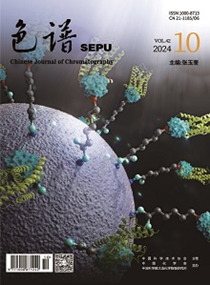With the growing global popularity of traditional medicine and natural drugs, especially in Southeast Asia, the quality of traditional Chinese medicines (TCMs) has attracted the attention of regulators. China's major TCM export destinations, such as South Korea, Japan, and Europe, have formulated strict maximum residue limits (MRLs) of pesticides in TCMs. Therefore, a sensitive and high-throughput method for the simultaneous determination of 101 pesticide residues in Platycodonis radix and extracts of Angelica sinensis was established, involving gel permeation chromatography (GPC) coupled with gas chromatography-ion trap mass spectrometry (GC-ITMS). In this method, the samples were first ground into fine powder and extracted twice with 20 mL acetonitrile in an ultrasonic cleaner for 30 min. After centrifugation for 10 min at 6000 r/min, the supernatants were combined and dried at 40 ℃ using a rotary vacuum evaporator. The residue was re-dissolved in 2 mL ethyl acetate-cyclohexane (1∶1, v/v) and purified by gel permeation chromatography using a 40 cm×20 mm column. The eluent collecting time was optimized as 17-30 min to ensure both the recovery of target compounds and the removal of interferences such as pigments and lipids from the target compounds. The eluent was then dried and re-dissolved with 1 mL toluene for analysis. The 101 pesticide residues were separated using the DB-5MS capillary column and analyzed by ion trap mass spectrometry. The pretreatment conditions and ion trap mass spectrometry parameters were optimized to effectively reduce the interference of complex TCM matrices and greatly improve the quantitative accuracy of the analysis and recovery of the target pesticides. Three spiked levels of 101 pesticides were tested. The average recovery range was 58.3%-108.9% and the relative standard deviations (RSDs) at the three spiked levels (n=10) ranged from 0.4% to 16.5%. The limits of detection (LODs, S/N=3) of the 101 pesticide compounds ranged from 0.2 to 40.0 μg/kg, while the limits of quantification (LOQs, S/N=10) ranged from 0.6 to 120.0 μg/kg, which met the maximum residue limits of China's main TCM export countries and organizations. This rapid analysis method was easy to operate and high throughput, with strong sensitivity and good repeatability. The employment of gel permeation chromatography overcame the drawback of inadequate cleanup of the solid phase extraction column during TCM analysis. The application of ion trap technology further eliminated the interference of matrix impurities and increased the accuracy of the quantitative and qualitative analyses. This method fills the knowledge gap in multiple pesticide residue determination in TCMs using gas chromatography-ion trap mass spectrometry and is a useful and beneficial alternative to current analytical methods of TCMs.





